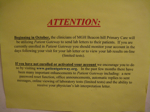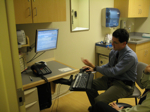Sites Visited

Challenges with Patient Adoption
This seemed to be the hallmark of the multispecialty groups we visited, all with different organizational structures. Harvard Vanguard is a private multispecialty group, has an existing patient portal, MyHealth Online, as does Partners Health Care, in Patient Gateway. John Muir Physicians have chosen the RelayHealth platform, but have not yet implemented it across all care sites.
In observations at the practice level, we noticed an enthusiasm for PHRs in both HVMA and Partners, and both organizations are putting some effort toward promoting adoption. For example, brochures at nurses stations.
At the same time, the messages at times seemed ambiguous at the level of the patient. For examples, physicians in practices served by Patient Gateway are communicating with patients outside of the Patient Gateway environment, using electronic mail. Partners has a Physician Leader accountable for Patient Gateway’s success. Harvard Vanguard Medical Associates does not. There was not a consistent approach among physicians at sites we visited (both Boston organizations) with regard to explaining the benefits of these tools to patients. We also noticed signs like the one pictured here, which describe a workflow that makes less sense in the presence of a personal health record system.
Independent acts of adoption were visible, however, at several sites, such as Masschussetts General Beacon Hill Primary Care, where Administrative Manager Richard Perrotti has worked with medical staff to integrate Patient Gateway into the care experience. In addition, practices that we observed were interested in ideas to promote adoption from others engaged in PHR use in practice, which leads us to believe that there is receptivity to a consistent message about benefits.
Data in a recently published article demonstrates flat adoption curves (see: Halamka JD, Mandl KD, Tang PC. Early Experiences with Personal Health Records. J Am Med Inform Assoc 2008;15:1-7) for other institutions local to HVMA and Partners, most notably Beth Israel Deaconess Medical Center. This is despite the fact that these organizations do not charge additional fees for use of these services.
Internal, External, Technical Factors?
When on site in Boston, organizations we spoke with acknowledged that hurdles to promoting adoption originated in internal prioritization of multiple initiatives, as opposed to external factors. This may be prevent the application of resources to developing a coordinated approach to adoption.
We did not notice significant promotion of the PHR projects by these organizations’ payers that was visible in care environments.
Beyond these two factors, we noticed an uncertainty with regard to best practices to promote adoption. Just as there is no available “PHR Toolkit” for the operational aspects of PHR implementation, there is no available toolkit for promoting adoption among patients and providers. Several of the conversations I entered into concerned best practices from the experience of organizations with solid adoption records (e.g. contests, advertising, integration with clinical operations). In a personal conversation with Maureena Moran, the Executive Director of Web Services for Group Health Cooperative, it was felt that this information (adoption strategies and techniques) is in greater need compared to information about operational issues of the PHR itself.
Unresolved Issues
- Impact of internal (prioritization with other projects) vs. external (reimbursement, local markets) forces in promoting adoption
- Availability of best practices and technical assistance in promoting adoption and operations integration
Countermeasures
Influence on internal forces is limited in a situation where an organization has already performed initial implementation of a PHR system. In this case, we are working with physician champions in both HVMA and Partners who are being transparent about their journeys on our blog.
With regard to external forces, it may be best to prioritize work with health plans as a factor in promoting adoption for groups in this situation. We also plan to follow the John Muir experience as they begin rolling out their product.
The need for leadership and technical guidance in adoption strategy may be greater than previously thought. A toolkit for organizations with challenges in adoption, produced by organizations that have achieved excellent adoption would be useful.
Ways to Engage
Our observations demonstrate the importance of having a vision that is clear from the board room to the exam room (See: Patient-Centered Care: What Does it Take?). In the case of these organizations, it seems most useful to interact with leadership accountable for setting priorities (ie Medical Directors of Informatics or Quality and their business partners) to find out where PHRs fit in first. Where PHRs have the potential for high prioritization, further engagement may be the most useful.
There is a second level of engagement that would also be useful, which is a the level of the Web or Internet services teams. These groups likely have accountability for successful use of the system and would benefit from interacting with peers in the industry to leverage investments already made.

